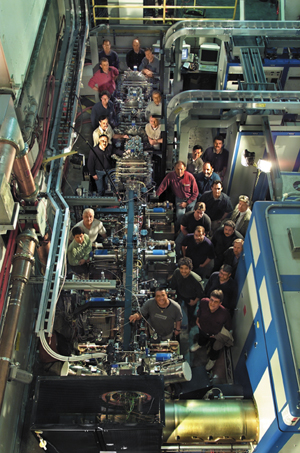|
|
 |
|
| |
 |
| Members of the Berkeley
Lab Front End Group are shown here with the successfully
completed and commissioned front-end system for the Spallation
Neutron Source (SNS). With a team of more than 40 scientists,
engineers, and technicians, Berkeley Lab was the first
SNS partner to complete its part of the project-on time
and on budget. |
|
| |
|
The SNS is a $1.4 billion multilaboratory collaboration
sponsored by the U.S. Department of Energy (DOE) to provide
the world's most intense pulsed beams of neutrons. Neutrons
are the chargeless particles that exist within atomic nuclei
along with protons, their positively charged counterparts.
Because of their electrical neutrality, highly energized neutrons
can be used as deep-penetrating, nondestructive probes. When
a beam of neutrons is directed into a sample material, most
pass through, but some bounce off atomic nuclei, a "scattering"
that reveals much about the positions, motions, and magnetic
properties of those nuclei. From studying the decay of bones
during osteoporosis, to improving the storage capacity of
CDs and DVDs, to making more accurate weather forecasts from
satellite data, the science of neutron scattering provides
unique insights into the properities of solid materials.
The SNS will be located at Oak Ridge National Laboratory (ORNL)
in Tennessee and is scheduled to begin operations in 2006.
It is designed to deliver an average of 1.4 million watts
of neutron beam power onto a target--nearly 10 times the capacity
of today's most powerful pulsed neutron sources. In addition
to Berkeley Lab and ORNL, the other collaborating partners
on the SNS are Argonne, Brookhaven, and Los Alamos national
laboratories, and the Jefferson national accelerator facility.
Each of the SNS collaborating partners was assigned a specific
responsibility. Berkeley Lab's was the front-end system, which
generates a beam of negative hydrogen ions and prepares it
for delivery into a linear accelerator. From there, these
negative ions will be energized to about one billion electron
volts in a one-millisecond long pulsed beam and injected into
an accumulator ring. Upon entering the ring, the negative
ion beam is converted into a proton beam and compressed into
one microsecond pulse-lengths. It is then extracted from the
ring and smashed into a mercury target to produce neutron
beams that can be moderated and guided into designated experimental
stations.
|
|
| |
"This milestone
should serve as evidence that a collaboration like this
can work, and that DOE laboratories can effectively combine
resources to serve our nation's needs." |
|
|
"Berkeley Lab is proud to be the first of the SNS partners
to deliver our project on time and on budget," said Berkeley
Lab Director Charles Shank when the front-end system was officially
commissioned. "This milestone should serve as evidence
that a collaboration like this can work, and that DOE laboratories
can effectively combine resources to serve our nation's needs."
Said SNS Project Director Thom Mason at ORNL, "As the
first SNS partner lab to complete its part of the project,
Berkeley Lab is leading the way to successful completion of
SNS, on time and on budget. We at Oak Ridge National Lab are
grateful for the skill and dedication of the Front End team
at Berkeley and the outstanding job it has done."
The SNS front-end system consists of a negative hydrogen ion
source, low-energy beam transport (LEBT) system, radio-frequency
quadrupole (RFQ) accelerator, and medium-energy beam transport
(MEBT) system. A low-energy beam of negative hydrogen ions
created in the first two components is passed into the RFQ,
which groups the beam into discrete pulses and accelerates
them to 2.5 million electron volts. The MEBT creates short
gaps in the pulsed beam by chopping it into minipulses of
645 nanoseconds duration, with separations of 300 nanoseconds,
in order to facilitate the beam's ultimate extraction from
the SNS accumulator ring.
"The completion and successful commissioning of the SNS
front-end system has been a huge triumph for us and a terrific
accomplishment for the Front End team," says Rick Gough,
the physicist who heads the Ion Beam Technology (IBT) program
for Berkeley Lab's Accelerator and Fusion Research Division
(AFRD).
Construction of the SNS front-end system began in October,
1998, and the projected costs for making it were about $20
million. The system was assembled and tested, component by
component, by a Front End Group team that included more than
40 scientists, engineers and technicians.
"That all of the technical challenges in making this
system were so successfully met is a credit to the team effort
that has characterized the work of the Front End Group throughout
this project," Gough says.
In addition to Gough, key members of the Front End Group
included physicist Rod Keller, who served as senior team leader
with overall responsibility for the SNS Front End Group, physicist
John Staples, who led the design of the RFQ and MEBT, and
physicist Rainer Thomae, who led the design of the negative
ion source/LEBT, all with AFRD; and project manager Ron Yourd,
chief engineer Richard DiGennaro, lead electrical systems
engineer Alex Ratti, and lead control systems engineer Steve
Lewis, all with Berkeley Lab's Engineering Division.
-- Lynn Yarris
|


